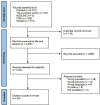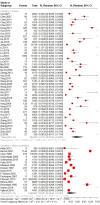Prevalence of developmental dysplasia of the hip (DDH) in infants: a systematic review and meta-analysis
- PMID: 37879719
- PMCID: PMC10603435
- DOI: 10.1136/bmjpo-2023-002080
Prevalence of developmental dysplasia of the hip (DDH) in infants: a systematic review and meta-analysis
Abstract
Objective: To estimate the prevalence of developmental dysplasia of the hip (DDH) in infants with a systematic review and meta-analysis.
Method: A literature search was conducted in April 2023, using databases such as Cochrane Library, PubMed, MEDLINE, CNKI, and SinoMed, without language restrictions. Eligible studies included cross-sectional studies reporting the prevalence of DDH among infants aged 0-12 months. Two independent reviewers manually selected and coded the studies, with any disagreements resolved by a third reviewer. Meta-analysis was performed using a random-effects model to calculate the prevalence of DDH. Regression analysis examined the trend of DDH prevalence, and stratification analysis explored heterogeneity between studies.
Results: A total of 65 studies involving 3 451 682 infants were included in the meta-analysis. None of the studies were classified as high quality, four were medium-to-high quality, 50 were low-to-medium quality, and eight were low quality. The pooled prevalence of DDH was 1.40% (95% CI: 0.86 to 2.28, I2=100%), and prevalence of dysplasia, subluxation, and dislocation was 1.45% (95% CI: 0.93 to 2.24, I2=97%), 0.37% (95% CI: 0.22 to 0.60, I2=94%), and 0.21% (95% CI: 0.13 to 0.34, I2=92%), respectively. Notably, the overall prevalence has a slight upward trend in the last three decades (β=0.24, p=0.35), but the dysplasia was downward trend (β=-0.48, p<0.01). Girls have higher risk of DDH than boys (1.46% vs 0.66%; Q=5.83, df=1, p=0.02). There were no significant differences based on gender, country, setting, or screening technique.
Conclusion: The prevalence of DDH among infants is approximately one in a 100, with girls being at higher risk. Though the prevalence of dysplasia has decreased, there is a slight upward trend in overall DDH. Therefore, routine screening for DDH in infants is recommended to prevent more serious developmental problems.
Keywords: Infant; Neonatology.
© Author(s) (or their employer(s)) 2023. Re-use permitted under CC BY-NC. No commercial re-use. See rights and permissions. Published by BMJ.
Conflict of interest statement
Competing interests: None.
Figures
References
-
- Johns Hopkins Medicine . Developmental dysplasia of the hip. 2022. Available: https://www.hopkinsmedicine.org/health/conditions-and-diseases/developme...
Publication types
MeSH terms
LinkOut - more resources
Full Text Sources
Research Materials
Miscellaneous






